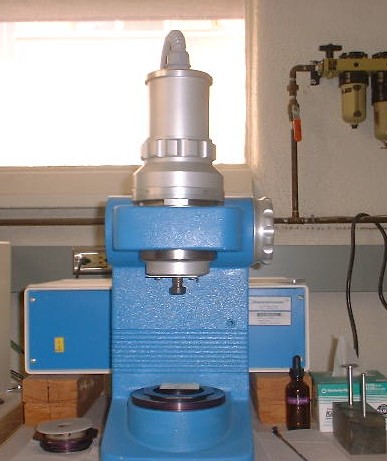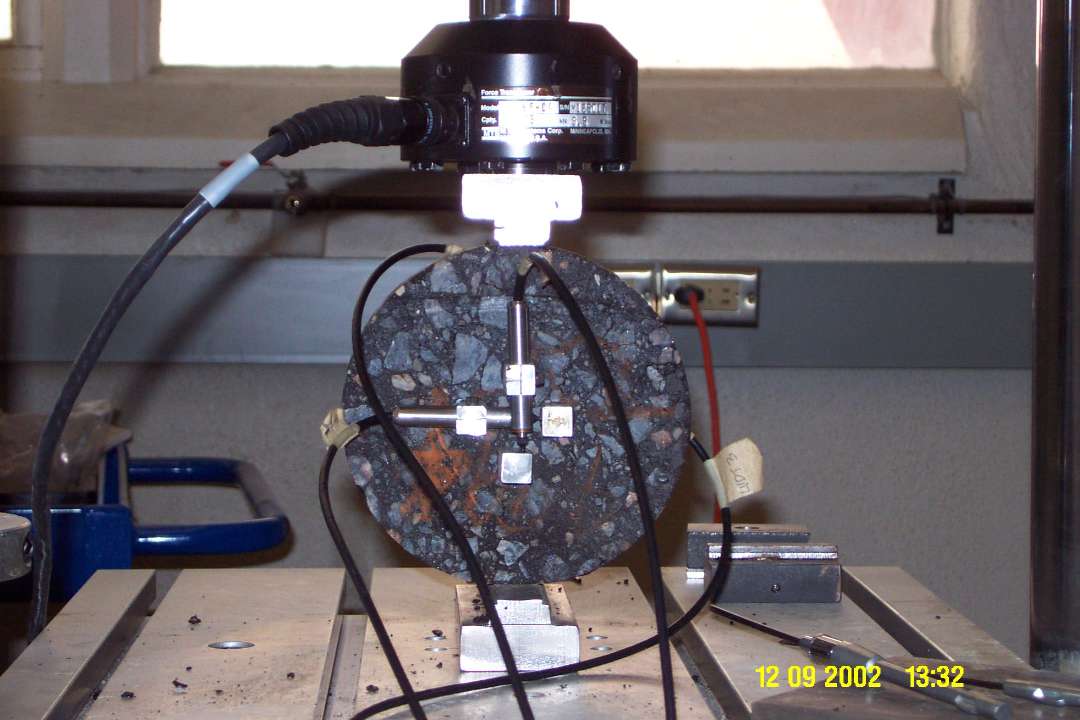Research Projects
1. Laboratory determination of resilient modulus of subgrade
and base materials
AASHTO (American Association of State Highway
and Transportation Officials) guide for the design of pavement
structures recommends the use of soil resilient modulus to
represent the dynamic strength of subgrade soil which can be
obtained from repeated load tests. Using of empirical
equations to estimate soil resilient modulus leads to
incorporating a higher safety factor in pavement design to
overcome the uncertainty about the actual soil dynamic
strength.
Accurate determination of soil resilient modulus reduces the
uncertainty about soil strength and optimizes the use of
limited infrastructure resources by improving design
reliability.
The objective of this project is to evaluate the resilient modulus of typical soils in Manitoba and the relationship between soil resilient modulus and other soil parameters. A testing system has been achieved to implemented and calibrated to measure soil resilient modulus of soil resilient modulus for typical soils in Manitoba. The output of this project will be used by Manitoba Infrastructure and Transportation (MIT) to optimize the design of pavements.
2. Laboratory-based evaluation criteria for hot-pour bituminous sealants
Sealing pavement joints and cracks is one of the essential pavement maintenance practices to protect subsurface layers from the ingress of moisture and debris. Hot-pour sealants are the most prevalent type of sealants and they consist of bitumen modified with polymers. Existing ASTM standards for hot-pour sealants are empirically based standards and may not correlate well with the field performance of sealants. Currently, field studies are the most reliable method to evaluate the performance of sealants in cold climates but such studies are slow and not cost-effective.
This research proposes a test protocol for full characterization of hot-pour bituminous sealants. Four test methods are adopted in this test protocol: Rotational Viscometer (RV), Dynamic Shear Rheometer (DSR), Bending Beam Rheometer (BBR), and Dynamic Mechanical Analyzer (DMA). These four tests characterize the rheological properties of sealants over the wide range of temperatures that they experience during installation and in-service. The major advantage of using these methods is that the equipment is readily available in the asphalt binder and polymer characterization laboratories; and the procedures are familiar to laboratory technicians.

3.Characterization of Pavement Surface Texture Using Photometric Stereo Techniques
This research aims to develop an image-based method for assessing pavement texture and in-turn friction and skid resistance characteristics. The method relies on taking several digital images of the surface from a stationary camera. With the camera location fixed, the lighting direction is changed from image to image. The images are combined digitally to construct a 3D digital surface model from which texture measurements can be made.4.Dynamic modulus of asphalt pavements
The dynamic modulus of asphalt concrete is a structural property that is required for design and analysis of performance. The project objectives were to determine typical values for the dynamic modulus and to investigate relationships between the dynamic modulus and the resilient modulus.
5.Modeling pavement response during Spring thaw
During spring the pavement thaws from the top down. As the increase in temperature travels through the surface layer and reaches the unbound aggregate base layer, the saturated base layer begins to thaw.
The excess water requires a long period of time to properly drain. During this period, the subgrade becomes considerably softer and decreases in stiffness, and the roadway experiences an increase in damage and reduction in service life. The duration of thaw for a typical pavement structure depends on soil type, moisture and thermal properties, air temperature, solar radiation, drainage and the location of the site. Spring load restrictions are applied to protect weak pavement structures that would otherwise experience excessive deflections. Nearly 58% of the Manitoba Provincial pavement network is subjected to spring load restrictions.
The purpose of this research is to relate pavement deflection
data from Falling Weight Deflectometer testing to
environmental indices such as the thaw index.
6.Asphalt mix strength properties and rutting performance
The main objectives of this study are to
investigate the rutting of in-service asphalt pavements and to
relate observed field performance to physical mixture
properties and strength parameters. Rutting is one of the most
common performance failures observed in asphalt pavements and
is generally attributed to one or more of the following:
1. Loss of surface material (wear rutting);
2. Subsidence of the underlying pavement structure (structural
rutting); or
3. Plastic deformation of the asphalt concrete layer
(instability rutting).
This study concentrates on asphalt mixture properties and
their relationship to rutting resistance, and as such focuses
entirely on instability rutting in Manitoba.

7.Asphalt mix characterization and evaluation
Determining layer coefficient and resilient modulus of Bituminous B (Bit B) and Bituminous C (Bit C) mix designs for asphalt paving that are used by Manitoba Department of Highways. Field testing and laboratory testing to determine the elastic moduli will be conducted on the two mix designs and examined and compared. The elastic moduli will be used to calculate the layer coefficients in accordance with the AASHTO 93 design guide. The results in the study wil assist in establishing appropriate layer coefficients for Bit B and Bit C when used in the design of pavement layers and overlays.
8.Concrete Filled Fibre Reinforced Dowels for Rigid Pavements

Corrosion of steel dowels in concrete pavements reduces their useful service life and creates considerable maintenance and repair expenditures for concrete pavements. Glass fibre-reinforced polymer (GFRP) dowel bars are a possible maintenance-free alternative that will potentially reduce the overall life cycle cost of pavements, especially in corrosive environments. Poster Presented at the 2003 ISIS Conference
9.Shredded Tires in Road Base
Waste tires have recently proved to be an ecological and financial burden in many regions of the world. In Canada, an equivalent of one waste tire per capita is added to the stockpiles annually. There are several applications for waste tires in road construction including lightweight embankments, crossing soft subgrade soils, pavement frost barriers, retaining walls and bridge abutment backfill, and as a drainage layer for edge drains. The road construction can utilize a large quantity of scrap tires but there is a shortage of technical data on design and performance.
Given this lack of technical data, a gravel-surfaced lightweight road embankment was constructed in Manitoba on a soft ground using large size (300 mm) tire shreds in the base layer. The objectives were to monitor the performance of the road, examine the thermal and mechanical behavior of the tire shreds and develop design guidelines for the construction of roads using tire shreds in the base layer. Performance of the road embankment was evaluated by establishing the thermal behavior of tire shreds from automated temperature measurements and from the evaluation of surface deflection of the tire shred embankment using 21,000 Kg dual-tandem axle load. The effect of tires shreds on the water quality was determined by conducting organic and inorganic water quality testing.
The research reports the performance-monitoring program of the road and development of a layered elastic-isotropic deflection model based on one-dimensional constrained compression laboratory tests on three sizes of the tire shreds. Design guidelines for roads constructed using shredded rubber tires are presented based on the laboratory testing, numerical model and field performance of the road.

10.Central Tire Inflation Technology
Central tire inflation (CTI) technology was originally developed in the 1940s to improve mobility and traction of wheeled military vehicles. The concept is that contact area between tire and road surface increases as tire pressure is reduced. The technology is now being implemented in the trucking industry. Since 1995, Saskatchewan Highways and Transportation (SHT) has permitted truck fleets to operate with primary highway axle loads on secondary highways; provided that these truck fleets operate with reduced tire pressures under a partnership program with SHT. The motivation behind this initiative is to minimize pavement damage by reducing both contact pressure and axle repetitions.
11.Automated Pavement Condition Assessment
Under a pilot testing program, the City of Winnipeg contracted EBA Engineering to collect road roughness data using highway-speed automated laser survey equipment. The survey was conducted in the fall of 2001. Due to recent advances in data collection hardware and software, the precision and quality of data have improved significantly. Several cities in Canada, the United States and Europe started to evaluate strategies for data collection and implementation of this data in managing complex urban road networks.

The research tasks associated with this project are:
- Conduct manual profiling of selected sections that were profiled by EBA
- Manual collection of surface distresses in co-operation with the City of Winnipeg
- Comparison of manual and laser-based surveys
- Assess the reliability of laser-based surveys
- Propose a framework for the effective implementation of automated pavement condition data in pavement surface evaluation, GIS mapping, and pavement management
.
.
.
